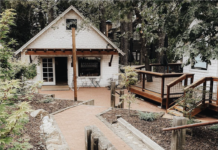As this past summer’s well-deserved centennial celebration for Ernie Maxwell fades into memory, I’d like to focus attention on an equally fascinating Idyllwild pioneer: George B. Hannahs, Jr.
His father was prominent in Michigan banking and lumber industries, eventually serving as state senator there before retiring to San Diego in 1887. Although George, Jr, was already a successful Chicago businessman, he and his wife, Sarah, followed his parents west. The young couple soon landed in San Jacinto, where at the age of 31 George, too, found himself in the lumber business.
Hannah immediately began buying timberland from the Southern Pacific Company, owner of half our mountain range. Just how much he bought is obscure, escalating as high as 5,000 acres in later recollections, but probably included much of our valley. What we know is that in 1889 he joined timber baron Anton Scherman’s Strawberry Valley Lumber Co. as partner and manager.
Scherman had just persuaded the San Diego County Board of Supervisors to revoke the toll franchise for the road up from Hemet. That brought an unanticipated flood of summer campers, a nuisance for loggers. Perhaps in an attempt at crowd control, Hannahs began to charge for camping on company property, even provided primitive lodging and board. He quickly realized the campers offered a more promising long-term future than the fast-disappearing forest.
So in 1890 George and Sarah Hannahs – she seemed to have a key role in their enterprises – established their own private campground they variously called “Idylwilde Camp” or “Camp Idylwilde.” They charged campers nothing, but introduced enticements that would generate income: grocery store, bath house, laundry, furnished tent cottages, later a hotel and dining room with croquet and tennis courts. Their ads touted pasture for horses, fenced premises to keep out annoying hogs and cattle; good water from two springs, a well, and the creek; a shaded platform for Sunday services; the absence of a saloon on the premises; and their own stagecoach and luggage wagon to meet trains at San Jacinto.
In 1893 the couple got the jump on competition for the growing camper trade by moving to the mouth of the valley, where the Hemet road first crossed Strawberry Creek (today’s gateway to Idyllwild Arts). There they built a general store and landed a U.S. Post Office they named “Rayneta” for their son Raymond, Idyllwild’s first-born, with George as postmaster. Hannahs sold Camp Idylwilde in 1895 and returned to lumbering by forming the Native Lumber Company, with a main sawmill at Dutch Flat churning out boards for fruit crates.
It was probably Hannahs who in 1899 sold Walter Lindley some 1,500 acres in the upper valley for his Idyllwild Sanatorium. Anticipating increased traffic, Hannahs scraped out a new wagon route up from the Mountain Center area, longer but gentler than the treacherous slopes of the old toll road. Then in 1901 he moved his business to the newly developing resort settlement, got the post office officially renamed “Idyllwild,” and settled into a home on his land between Idyllwild and Dutch Flat.
Although he wangled a promotion to postmaster of San Jacinto in 1905, he soon was back, running the Idyllwild post office once more from his strategically located general store at the top of Lower Pine Crest Avenue, the last stretch of road into town from Hemet.
In 1913 he subdivided the area around his home under the name “Wildwood” and launched Idyllwild’s first serious land development, marketing lots through a series of hand-tinted postcards that remain in circulation among collectors today. A decade later he sold land that would become Pine Cove to a Long Beach group. When he died in 1931, his role as postmaster passed to Sarah.
As the most innovative and forward-looking of our pioneers, it is fitting that the Hannahs’ memory is perpetuated in the name they introduced: Idyllwild.









